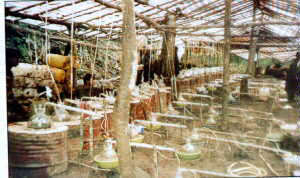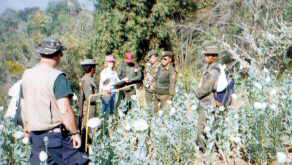Cooperation with the United
States
In her international
cooperation concerning the eradication of narcotic drugs, Myanmar cooperated
with the United States as well. Starting from 1974, the Department of States,
the Drug Enforcement Administration (DEA), the Criminal Narcotic Center (CNC),
the Department of Agriculture and Office of Strategic Services (l01) (
War-veterans organization) of the United States cooperated with Myanmar in areas
of narcotic drugs suppression and crop substitution programmes.
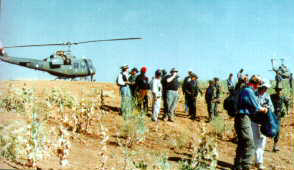 |
| Members
of Opium Yield Survey Team from the United States of America arriving to observe the poppy fields. |
Cooperation with the US Department of State
In 1974, the United States Administration offered to assist in the narcotic drugs
suppression efforts of Myanmar. On acceptance by the Myanmar Government of the offer ,the
Agreement concerning cooperation between the two countries was signed on July 1974. Since
then officials from the International Narcotic Matters (INM) of the Department of State and
those from the Ministry of Home Affairs, the Directorate of Defense Services Intelligence of
the Ministry of Defense and the Office of the Commander-in-chief (Air) of the Union of
Myanmar had began their cooperative efforts. The US Administration provided 6 Bell-205 type
helicopters in 1975, another 6 and one F-27 Fokker aircraft in 1976,7 Bell-205 type
helicopters, 1 Bell-211type helicopter and 5 F-27 Fokker aircraft in 1977, 1 Bell-205 type helicopter in 1979, 3 Thrush spraying aircraft in 1985 and l Thrush spraying
aircraft in 1986 and 7 Bell-206 type helicopters-numbering 39 assorted aircraft. Pilots from the Myanmar
Air force were also provided with training to operate the aircraft supplied. In addition, a total of 32 trainees from the Myanmar Tatmadaw and the Customs Department were sent to courses on narcotic drugs suppression conducted in the United States. Financing for the trainees was provided by the US Administration. Furthermore, a total of 29 Myanmar officials, including the Minister for Home Affairs, the Deputy Minister and the Director of the Defense Services Intelligence participated in meetings and study tours on narcotic drugs. From 1974 to 1988 the assistance provided by US administration for Myanmar’s effort to eradicate narcotic drugs amounted to the tune of US$.86.6 million.
| On the Myanmar side, with the cooperation of the
Tatmadaw, Myanmar Police Force and other departments, Melone Operation, Hninpan Operation, Paukpan Operation, Taunghtaikpan Operation, Hayman Oo Operation |
||
|
|
were launched in poppy growing regions from
1974 to 1979 to destroy poppy plantations. In the 1979-80 poppy-growing seasons Nge Ye Pan Operation was launched to destroy poppy plantations followed by a series of Nge Ye Pan Operations from Phase 1 to 8 from 1981 to 1988 to destroy poppy fields during poppy-growing seasons. From 1985 to 1988, Taungyanshin Operation from phase 1 to 4 were launched and poppy fields were destroyed using Thrush spraying aircraft. Thus a total of 19976.87 acres of poppy fields had been destroyed. Acting on the information furnished by the US Administration and the Directorate of Defense Services Intelligence, Myanmar Tatmadaw launched offensives using armed troops, aircraft and |
|
|
Ether Refinery seized in Muse township |
||
| helicopters against opium refineries, convoys of opium traffickers. In 1975 Mohein operations was launched followed by Mohein operation phase 1 to 12 of 1976,1977,1978,1980,1981 1983, 1984, 1985, 1986, 1987 and 1988 respectively. | ||
|
In its interdiction operations which conducted from 1975 to 1988, in cooperation with the Department of State, the Myanma Tatmadaw seized 5453 kilos of opium 159.61 kilos of heroin, 344.68 kilos o morphine,2033 gallons of |
||
| liquid opium,25′ assorted weapons, 2364 mines, 70607
rounds of assorted ammunitions, 19 unites of communication equipment, 15 heroin refineries and 205 enemies were captured dead with 18 captured alive. In the Mohein Operation 109 members of the Tatmadaw lost lives and 572 were injured.
In September 1988, the U.S. State Department discontinued its assistance to and cooperation with Myanmar. Despite this, shift in the policy of the US government, Myanmar has continued its efforts for the eradication of narcotic drugs, which is regarded as a national responsibility, with or without assistance. |
|
|
|
Myanmars and Americans cordially conducting yield survey in a poppy field. |
||
Cooperation with the Drug Enforcement Administration
(DEA)
In 1979, the Drug Enforcement Administration of the United States stationed
one attaché at the US Embassy in Myanmar to act as liaison for narcotic drugs suppression
measures. At that time, an official for the DEA’s branch office in Thailand was sent over to
Myanmar. Commencing 1979, a branch of the DEA was attached to the US Embassy in Myanmar.
Since 1979, the DEA Branch has been cooperating actively in the field of narcotic drug
suppression. It has collected information on poppy-growing areas, heroin refineries, transit routes, drug traffickers, money-laundering and has conveyed the information thus collected to the authorities concerned of Myanmar .This cooperation had led to successful operation against drug refineries, poppy plantations and drugs convoys. In addition, it was under the sponsorship of the DEA that officials from the Myanmar Tatmadaw and Myanmar Police Force were sent to courses and workshops conducted in the US, Germany and Hongkong to enhance their technical know-how.
In 1984, the DEA established direct contact with the Directorate of the Defense Services Intelligence concerning narcotic drugs and enhanced cooperation . Since September 1988, when the US Administration shifted its
drug policy towards Myanmar, there have been limitations to the cooperation provided by
DEA. However, Myanmar side has continued to keep up its cooperation with the
DEA as before. Even after 1988, the DEA transmitted information on heroin refineries and
convoys of drug traffickers to the DDSI. This exchange of information and coordination
between the two sides resulted in successful and effective interdictions. Through this cooperation,
106 opium refineries were destroyed between 1988 and 1998. Based on the information provided
by the DEA, seizures of precursor chemicals were also made.
From 1992 to 1994, the DEA and the Directorate of Defence Services Intelligence
(DDSI) cooperated in operations to trap a drug cartel engaging in large-scale trafficking. The
DEA units in Chiang Mai and Yangon cooperated to crush the drugs gangs along the Thai-Myanmar border where the DEA provided
communications systems to enable coordination between the Narcotic Suppression Bureau
(NSB) of Thailand and the narcotic task forces and the Myanmar Police Force. In 1997,
when the narcotic suppression units of Thailand launched mopping-up operations
against opium refineries in Thai territory, the DEA coordinated to enable the Myanmar side to block the escape route of drugs traffickers In 1997, Myanmar cooperated with the DEA’ in the arrest of the drug convict Lee Yun Chun who had fled from Thailand and for his extradition to the US through Thailand
Cooperation with the Criminal
Narcotic Centre (CNC) in Opium Field Survey
The Criminal Narcotic Centre (CNC) of the United States proposed to cooperate with Myanmar in region-wise
opium field survey in poppy-growing regions Myanmar accepted the proposal and joint surveys were conducted with American
experts. From 13 to 19 February 1993, opium field surveys were conducted during the
poppy-growing season on poppy fields clandestinely grown in Kutkhai, Tarmohnge,
Shaukmohnge, Shauk haw, Lonhtan, Lwewinye, Monsi, Kunlon, Kamine, Panlonkhwin in Northern
Shan State, Mongyang, Hsilu, Mongkhat Wanla in Eastern Shan State, Pinlong Township, Pinlong /
Mobwe, Hopone, Mongin, Southern Shan State. The United States team led by Counselor
Mr. Athur Brown with Mr. Lloyd Armstead from CNC, Mr. Mike Phelan from DEA, Mr. Mark
Taylor from the Narcotic Bureau of the State Department, Mr. Tierney from the Agriculture
Department participated in the study tours on opium survey. From the Myanmar government,
Lt. Col. Khin Maung Thein, General Staff Officer Grade I of DDSI acted as the team
leader and together with responsible officials from the CCDAC and the Ministry of Agriculture participated in the survey. Poppy seeds and soil collected from the poppy fields were tested at the laboratory in Chiang Mai for yield estimates by officials of the Tatmadaw and 3 agricultural experts from Myanmar in cooperation with American experts.
Although opium field survey for the poppy-growing season of 1993-94 was not conducted, at the request of the US Administration through the US Embassy, poppy seeds from the clandestine poppy fields in areas in northern, southern and eastern Shan State were collected in the manner requested by US experts and conveyed to American experts through the
DDSI.
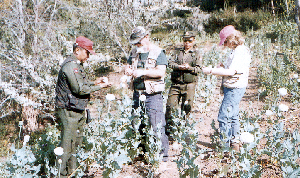 |
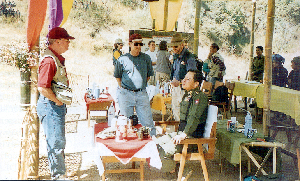 |
| Members
of opium yield survey team on a field work. |
A
coordination meeting on opium yield survey in session at T Moe Nye area of Northern Shan State. |
In 1995, yield surveys on clandestine poppy fields were conducted in Mongyang,
Mongphyan, Kengtong, Mongin, Mongshin, Mongpan, and Pahtan in eastern Shan State and
Kutkhai, Lonhtan, Shoukhaw, Monkhopyin, Kunlon, Lwepanye/Panlan in northern Shan
State. The US Administration was represented by Counselor Mr. Barry Brown (Leader), Ms. Sue
Bromley and party from CNC, Mr. Mark Taylor and party from State Department Narcotic
Bureau, and Mr. Gary Carter of DEA, Dr. Mary Cook from the Department of Agriculture totaling
10 members. Myanmar government was represented by Lt. Colonel Khin Maung Thein, General Staff Officer Grade I of DDSI as leader
and by the responsible officials from the CCDAC and the Ministry of Agriculture.
During 1995-96 poppy-growing season, poppy seeds collected from the clandestine poppy
fields in the Shan State were sent through the US Embassy to laboratories in the US under the
arrangement of the DDSI. In another cooperation of opium yield survey in 1997, poppy seedlings were collected from clandestine poppy fields in Hopone Township, Mene Range in southern Shan State, Mong-hsat and Mongkhot in eastern Shan State, Mahtu Township, Tangyang Township in northern Shan State, Konkyan Township in
Kokang, Monko, Phangsai / Haymoelone. Twelve US citizens, including Counselor Mr. Thomas Murphy as leader, Mr. Douglas Rasmussen, Deputy Chief of Mission of the US Embassy, Ms. Sue Bromley from CNC, Mr. Kevin Brown from State Department Narcotic Bureau and Mr. Daniel Moore from DEA participated. From the Myanmar side, responsible officials from CCDAC and Ministry of Agriculture, led by Colonel Kyaw Thein of the Office of Strategic Studies took part.
 |
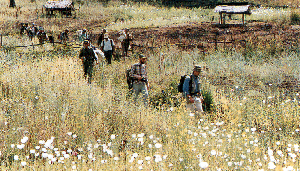 |
| Myanmar
Air Force on a mission to conduct opium yield survey. |
Americans
and Myanmars working together for opium yield survey. |
Fourth opium survey was conducted from 16 to 21 February l 998 in Panlong area
in Panlong Township, Mongpan area in Linkhay Township, Lecha area in Lecha Township in
southern Shan State, Walin area in Wa region, Panlong area of Hopan Township, Tanyang area
of Tanyang Township in northern Shan State. During the survey, documentary photos were
taken of clandestine poppy-fields in Manton region of Namtu Township and Myintan Range
of Kunlon Township. A 15 member US team with Counselor Mr. Thomas Murphy (leader)
and Deputy Chief of Mission Mr. Douglas Rasmussen of the US Embassy, Ms. Sue Brownley of CNC, Mr. Kevin Brown of State
Department Narcotic Bureau and Mr. Bruce Upchurch of DEA participated Colonel Kyaw
Thein of Office of Strategic Studies (leader) and responsible officials of the CCDAC and the
Ministry of Agriculture participated from the Myanmar side.
In the 1993 opium field survey, a team from the Department of Agriculture
of the US Administration assisted the agricultural experts from Myanmar with methods of opium yield survey and lab equipment. From 1994 to 1998, laboratories of the Ministry of Agriculture
and Irrigation received assistance on technology and a few equipment. The method of opium yield surveys had potential for use in survey of other crops.
Cooperation with Office of Strategic
Services (101)(War veterans organization)
Members of the Office of Strategic Services (101) who had served in Myanmar during World War II from 1941 to 1945 sought permission to work for regional development and the elimination of opium in Kutkhine in northern Shan State. In a spirit of cooperation, the government of Myanmar
complied with the request. This led to cooperation between Mr. Peter K. Lutken, Chairman of OSS
(101) and project manager Mr. Jorden Coldwell,
agronomist from Texas A & M University and responsible officials from Office of Strategic
Studies, the DDSI and the Ministry of Agriculture and Irrigation. From 1996 to 1998 US$ 530,000
was spent in this cooperation to grow 700 acres of corn, 53 acres of buckwheat, and 150 acres of
maize in 5 villages of Namtu Township and in 20 villages of Kutkhai Township as substitute crops.
